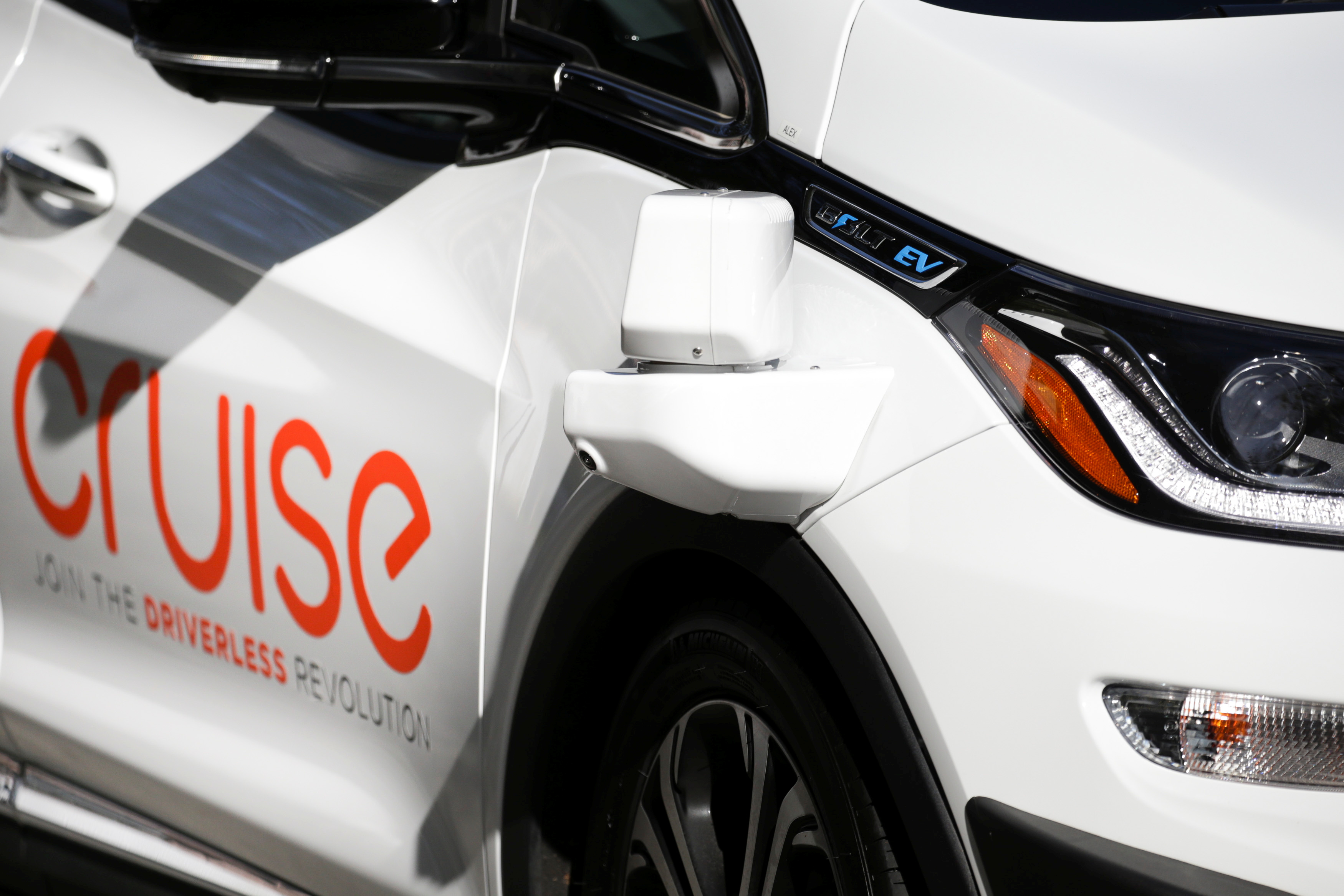[1/2]A close up of a Bolt EV car is seen during a media event by Cruise, GM’s autonomous car unit, in San Francisco, California, U.S. November 28, 2017. REUTERS/Elijah Nouvelage Acquire Licensing Rights
SAN FRANCISCO/WASHINGTON, Oct 24 (Reuters) - California on Tuesday ordered General Motors' (GM.N) Cruise unit to remove its driverless cars from state roads, calling the vehicles a risk to the public and saying the company had "misrepresented" the safety of the technology.
California's Department of Motor Vehicles (DMV) said it suspended Cruise's autonomous vehicle deployment and driverless testing permit, ending efforts by the company for the time being to test the cars without safety drivers.
"Based upon the performance of the vehicles, the department determines the manufacturer's vehicles are not safe for the public's operation," the DMV said in a statement, citing "an unreasonable risk to public safety."
The DMV added that Cruise had "misrepresented any information related to safety of the autonomous technology of its vehicles." The state agency said Cruise is allowed to challenge the suspension within five days. The company did not say if it planned to do that.
The suspension, following a series of accidents involving Cruise vehicles, is a major setback to the self-driving business that GM has called a major growth opportunity and to the autonomous vehicle (AV) industry. But unionized transit workers and other critics of robotaxis hailed the suspension, which was effective immediately.
"This could be a big blow to Cruise," said Bryant Walker Smith, a law professor at the University of South Carolina. "This plays into the narrative about the technology and the companies failing. The whole industry will suffer as a result."
Cruise said in a statement: "We will be pausing operations of our driverless AVs in San Francisco. Ultimately, we develop and deploy autonomous vehicles in an effort to save lives."
Cruise said the DMV was reviewing an Oct. 2 incident, where one of its self-driving vehicles was braking but did not avoid striking a pedestrian previously struck by a hit-and-run driver.
"When the AV tried to pull over, it continued before coming to a final stop, pulling the pedestrian forward," Cruise said.
"Our teams are currently doing an analysis to identify potential enhancements to the AV's response to this kind of extremely rare event," it added.
The DMV order said Cruise had not initially disclosed all video footage of the accident and said "Cruise's vehicles may lack the ability to respond in a safe and appropriate manner during incidents involving a pedestrian."
Cruise could not immediately be reached to comment on DMV report the company had not initially shared all videos of the incident.
GM executives have repeatedly called Cruise a giant growth opportunity, repeating that view during an earnings conference call on Tuesday before California's DMV announced its decision.
"We do believe that Cruise has tremendous opportunity to grow and expand," GM CEO Mary Barra told analysts. "We ... see tremendous upside opportunity and growth."
In June, Barra reiterated a forecast that Cruise could generate $50 billion a year in annual revenue by 2030. The company reported on Tuesday that it lost $723 million on Cruise during the third quarter.
In her call before the ruling, Barra said Cruise robotaxis have better safety records than human drivers.
In August, the DMV said it was investigating "concerning incidents" involving autonomous vehicles operated by Cruise in San Francisco and asked the company to take half its robotaxis off the roads. That month, a Cruise robotaxi was involved in a crash with an emergency vehicle in San Francisco.
This month, U.S. auto safety regulators opened a probe into whether Cruise was taking sufficient precautions with autonomous robotaxis to safeguard pedestrians.
The National Highway Traffic Safety Administration (NHTSA) said it has received two reports from Cruise of incidents in which pedestrians were injured, and identified two further incidents via videos posted on websites.
NHTSA said its investigation into Cruise remains open, but declined to comment on the California DMV action.
Two months ago, California allowed Alphabet Inc's (GOOGL.O) Waymo and Cruise to take paying passengers day or night throughout San Francisco, a significant step.
Waymo declined to comment on the DMV action.
Critics of the self-driving technology pounced on the DMV decision.
The Transport Workers union of America (TWU), which represents airline, railroad, and transit workers and has harshly criticized self-driving vehicles, said in a statement that companies like Cruise must meet measurable safety standards.
"Despite the propaganda pushed by tech executives, Cruise has shown the world that robots are incapable of even coming close to achieving the high standards human operators meet each and every day,” TWU President John Samuelsen said.
Reporting by Hyunjoo Jin and David Shepardson, additional reporting by Greg Bensinger; Editing by David Gregorio
Our Standards: The Thomson Reuters Trust Principles.
